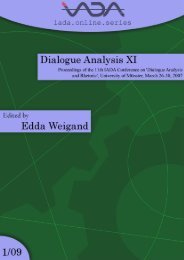Dialogue in and between Different Cultures - International ...
Dialogue in and between Different Cultures - International ...
Dialogue in and between Different Cultures - International ...
Create successful ePaper yourself
Turn your PDF publications into a flip-book with our unique Google optimized e-Paper software.
Cultural <strong>Dialogue</strong> <strong>between</strong> France <strong>and</strong> Spa<strong>in</strong><br />
The Contrat Première Embauche <strong>in</strong> the News<br />
Natàlia Izard & Clara-Ubald<strong>in</strong>a Lorda<br />
Universitat Pompeu Fabra (Barcelona, Spa<strong>in</strong>) 1<br />
The article takes a look at the heterogeneous genre of television news. It compares the<br />
different accounts of the same story by different television channels <strong>in</strong> France <strong>and</strong> Spa<strong>in</strong>.<br />
The comparison shows different modalities of ‘cultural translation’. Argu<strong>in</strong>g <strong>and</strong><br />
demonstrat<strong>in</strong>g by means of an analysis of the Contrat Première Embauche the analysis<br />
shows that the presentation of news or rather a conflict is either trivialized or enlarged<br />
by the other countries media.<br />
1. Introduction: The genre of television news<br />
The genre of television news is becom<strong>in</strong>g more <strong>and</strong> more heterogeneous. From a<br />
textual po<strong>in</strong>t of view, this genre, no doubt, belongs to the mass media modality of<br />
“reported event” 2 . However, there is a clear comb<strong>in</strong>ation of narrative sequences<br />
(of relation of actions/events) 3 <strong>and</strong> of descriptions <strong>and</strong> commentaries <strong>in</strong> the texts<br />
produced by journalists address<strong>in</strong>g their viewers from a studio or from the place<br />
of events. To this we must add the <strong>in</strong>sertion of live witnesses’ accounts <strong>and</strong><br />
footage of the events.<br />
The agenda sett<strong>in</strong>g varies from country to country <strong>and</strong> also depends on the<br />
TV channel. We can nevertheless put forward the follow<strong>in</strong>g hypotheses.<br />
− The events are more widely shown <strong>in</strong> the countries where they happen<br />
− These events are talked about <strong>in</strong> neighbour<strong>in</strong>g countries; <strong>in</strong> which case, there<br />
is a need for contextualization <strong>and</strong> extra <strong>in</strong>formation<br />
− The comparison <strong>between</strong> the <strong>in</strong>formation given <strong>in</strong> the source country <strong>and</strong> the<br />
target country constitutes a manifestation of the cultural dialogue <strong>between</strong> the<br />
1<br />
This paper is part of the research done <strong>in</strong> the project «Géneros dialogales del discurso político»<br />
HUM2005-01604/FILO). The research by Dr. Izard is done <strong>in</strong> the frame of the Grup Consolidat<br />
des Universités catalanes «Grup de Recerca del Centre d’Estudis de Discours i Traducció», <strong>and</strong><br />
Dr. Lorda’s <strong>in</strong> the group «Grup de Recerca d’Estudis de Discurs» (GED).<br />
2<br />
Charaudeau dist<strong>in</strong>guishes three discursive treatment modes of the event: the reported event, the<br />
commented event <strong>and</strong> the provoked event (1997:165-194).<br />
3<br />
Accord<strong>in</strong>g to the dist<strong>in</strong>ctions by the Centre d’Analyse des Discours de l’Université de Lausanne<br />
(cf. Revaz 1997).



